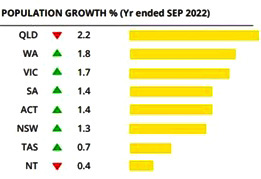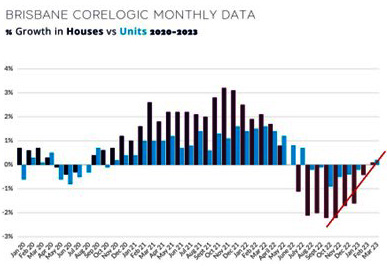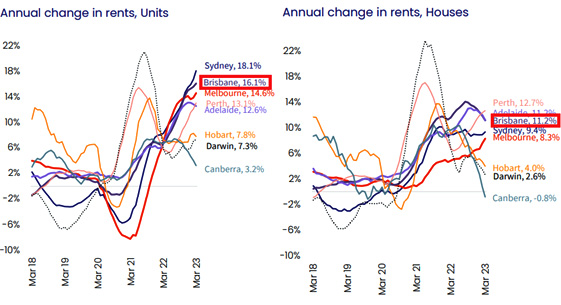Brisbane property returns to positive territory after year of declines
Brisbane's status as a magnet for migration, combined with low listings and high rental yields, has delivered property price growth to the Queensland capital for the first time in a year.
Brisbane's property market has returned to price growth for the first time in a year.
Houses and units both recorded capital growth, raising the prospect that a sustained period of decline may be at or near an end.
For the last few months, buyer activity in Brisbane has been increasing, based on the volume of people turning up at home opens, the number of registered bidders at auction and quantity of properties being sold with multiple offers.
This is occurring at the same time listing volumes stagnate. CoreLogic reported 17 per cent fewer new 'for sale' listings over the last 12 months in Brisbane.
While total listings have increased slightly (by 1.5 per cent) over the same period, there has still been an appetite for buyers to be much more selective in what they are looking to buy.
This means that B and C grade properties are taking a lot longer to sell, whereas quality properties are being taken off the market very quickly.
Clearance rates throughout March, on average, according to Domain were 53 per cent across Brisbane, which is slightly lower than last month.
Conversely, there has been no shortage of registered bidders at Brisbane auctions, with Apollo Auctions reporting an average of 3.7 registered bidders across the month at their auctions.

Source: CoreLogic
Sentiment on the ground has picked up once again. Competition for quality properties is high and there are frequent examples of sales that take place with multiple offers as well as multiple registered bidders.
Some people are wondering, how can this be? Weren’t property prices predicted to keep falling throughout 2023 according to a majority of economists?
It is interesting to see how property price predictions play out. It is rare for economists to get it right given they are usually sitting at a desk in an office somewhere, not seeing what is actually happening at the coal face.
What is driving property demand?
Despite the shortage of housing stock, Queensland is seeing significantly more migration than any other part of Australia.
That is translating into more people competing for properties that become available for sale. Breaking down the volume of the population growth in Queensland, there were 2,201 people entering the state every week.
With almost one third less stock on the market compared to the long-term average, it is no surprise a floor has been placed on property values.

Source: Australian Bureau of Statistics
Interest rates have been rising, contributing to cost of living pressures, but the most recent pause by the Reserve Bank of Australia (RBA) will provide further confidence for buyers that the top of the interest rate cycle has been reached or is near.
Rising interest rates are impacting lower income earners more than higher income earners, so not everyone is experiencing the same effects.
In a recent report, Tim Lawless, Executive Research Director, CoreLogic, stated, “Although interest rates are high and there is an expectation the economy will slow through the year, it’s clear other factors are now placing upward pressure on home prices.”
The median house price in Brisbane is also a lot more affordable than the cost of housing in areas such as Sydney and Melbourne.
Additionally, with rental markets so tight it is possible there might be some spillover from tenants who seek to buy instead of rent. Again, this will be dependent on their affordability levels.
Brisbane dwelling values recovering
While the fall in median house values in Brisbane was hard and fast from July 2022, the recovery at this stage appears to show a similar gradient. Of course, the months ahead may still have some headwinds, but things certainly appear a lot more optimistic.
For the first time since Mary 2022, according to CoreLogic data, Brisbane dwelling values showed positive growth in March, rising 0.1 per cent up from a 0.4 per cent decline during February. The quarterly growth trajectory is also turning around. Quarterly performance for Brisbane dwellings is now down 1.7 per cent, with the median value for a dwelling across Greater Brisbane at $698,071.

Source: CoreLogic
House values changes in Brisbane have turned around rapidly over the last four months.
In March, CoreLogic data showed a small increase of 0.1 per cent with the quarterly change now reported to be minus 2 per cent. The median value for a house in greater Brisbane is now $772,020.
Following the trend from previous months, there was more strength in the unit market compared to the house market throughout March.
Unit values increased 0.2 per cent over the month, with the median value recorded at $492,415.
Brisbane rental market tightening
Brisbane residential vacancy rates remain very tight and at record lows.
Across all of Greater Brisbane the current vacancy rate according to SQM Research is 0.8 per cent. With so few properties available for rent, coupled with high tenant demand, rents are still rising.
House rents in Brisbane have increased 11.2 per cent over the last 12 months, while unit rents have increased 16.1 per cent.
With this growth, rental yields have become much more attractive for property investors. Gross yields are currently 4.1 per cent for houses and 5.4 per cent for units.

Source: CoreLogic
A massive downside to the tightening rental market is that homelessness has increased, as evidenced by tent cities popping up in many areas throughout Brisbane.
According to the Queensland Council of Social Services, homelessness across Queensland has surged 22 per cent since 2017. More than 300,000 Queenslanders are experiencing housing insecurity.
The Queensland State Government needs to increase the delivery of public housing tenfold to keep up with current demand. This is not a situation that is likely to change soon.
Has the Brisbane property downturn has subsided?
The expected turnaround in property price changes in Brisbane has now arrived. Could this be the start of renewed investor optimism? Or is this just a momentary slowdown in falling prices?
Based on the fundamentals that drive property price changes, it is evident that across Brisbane there is very low supply and high demand.
Higher interest rates combined with high inflation levels have impacted some buyers but differently for everyone.
It is also important to remember there still are markets within markets.
The strongest market sector is the inner Brisbane precinct, such as Fortitude Valley, New Farm, Highgate Hill, South Brisbane, Teneriffe and West End.
These areas are typically occupied by higher income earners who can afford to pay higher property prices, or higher rents. This is another illustration of the fact that not all people are impacted in the same way by rising interest rates and higher inflation.
The full impact of the higher interest rates may not have yet flowed through to borrowers and we can expect some weaker economic activity in the months ahead.
Despite these headwinds, the weighting is now leaning towards more positive factors, including inflation falling, the RBA cash rate cycle approaching a peak, and high migration to Brisbane, and Queensland as a whole.
Fundamentals: this is what people should focus on. Getting caught up in the short-term changes in sentiment caused by transient factors can mean property buyers miss good opportunities.



















